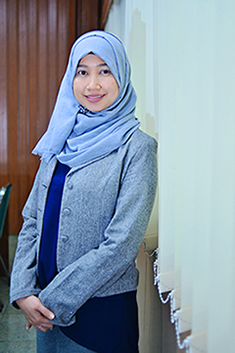Formulations and Antibacterial Activity of Shallot (Allium cepa L.) Peel Extract Patch against Streptococcus pyogenes
Downloads
Background: Bacterial pharyngitis is an inflammatory condition in the back of the throat caused by Streptococcus pyogenes. Patients are often prescribed antibiotics and antiinflammatories to alleviate pain and discomfort while reducing bacterial growth in the throat. However improper and prolonged use of antibacterial and antiinflammatory agents increases the risk of bacterial resistance and side effects. An often discarded Shallot (Allium cepa L.) peel rich in flavonoids with great antibacterial and anti-inflammatory properties is potentially used as an alternative treatment for bacterial pharyngitis. Objective: This study aimed to develop shallot peel extract as an antibacterial against Streptococcus pyogenes. Methods: Patch was formulated with variations in extract concentration of 5% (F1), 10% (F2), and 15% (F3) to observe their influence on weight uniformity, thickness, folding endurance, surface pH, moisture content, and antibacterial activity using disc diffusion. Results: All formulations produce slightly heavy and thicker but uniform patches (CV<5%), surface pH suitable for application in the skin (4.6-4.9), flexible and durable patches with high folding endurance (> 300 folds), good moisture content (<10%) and moderate to strong antibacterial activity (inhibition zone diameter ranging from 9 to 13.67 mm). Variations in extract concentration in the formula significantly influenced the thickness, weight, folding endurance, and also the antibacterial activity of the patches. Higher concentrations of extract produce thicker and heavier patches but stronger antibacterial activity against pharyngitis pathogens. Conclusion: Therefore, antibacterial patches containing up to 15% shallot peel extract are potentially used as an alternative treatment for pharyngitis.
Alkilani, A. Z., Musleh, B., Hamed, R., Swellmeen, L., & Basheer, H. A. (2023). Preparation and Characterization of Patch Loaded with Clarithromycin Nanovesicles for Transdermal Drug Delivery. Journal of Functional Biomaterials; 14; 1–21.
Andriani, D., Ovikariani, & Kusuma, E. W. (2024). Formulasi Sediaan Patch Transdermal Ekstrak Daun Belimbing Wuluh (Averrhoa bilimbi L.) dan Uji Aktivitas Antipiretik. Cendekia Journal of Pharmacy; 8; 254–264.
Atika, R. (2021). Perbandingan Kadar Flavonoid Pada Kulit Bawang Merah (Allium cepa L.) dan Kulit Bawang Putih (Allium sativum L.) dengan Metode Spektrofotometri Uv-Vis. Tugas Akhir; Politeknik Harapan Bersama, Tegal.
Badan Pusat Statistik. (2024). Produksi Tanaman Sayuran Menurut Provinsi dan Jenis Tanaman, 2023. Jakarta: Badan Pusat Statistik.
Badan Pusat Statistik Yogyakarta. (2023). Kota Yogyakarta Dalam Angka 2023. Yogyakarta: Badan Pusat Statistik.
Cots, J. M., Alós, J.-I., Bárcena, M., Boleda, X., Cañada, J. L., Gómez, N., Mendoza, A., Vilaseca, I., & Llor, C. (2015). Recommendations for Management of Acute Pharyngitis in Adults. Acta Otorrinolaringologica; 66; 159–170. doi: 10.1016/j.otoeng.2015.05.003.
Ding, Y., Yu, S., Wei, Z., Deng, R., Chen, P., Sun, Y., Jia, Q., Li, X., Wu, Y., Chen, W., Zanker, K. S., Wang, A., & Lu, Y. (2020). Relieving Sore Throat Formula Exerts a Therapeutic Effect on Pharyngitis through Immunoregulation and NF-κ B Pathway. Mediators of Inflammation; 2020; 1–21. doi: 10.1155/2020/2929163.
Fredotović, Ž., Puizina, J., Nazlić, M., Maravić, A., Ljubenkov, I., Soldo, B., Vuko, E., & Bajić, D. (2021). Phytochemical Characterization and Screening of Antioxidant, Antimicrobial and Antiproliferative Properties of Allium × Cornutum Clementi and Two Varieties of Allium cepa L. Peel Extracts. Plants; 10; 1–15. doi: 10.3390/plants10050832.
Fuziyanti, N., Najihudin, A., & Hindun, S. (2022). Pengaruh Kombinasi Polimer PVP:EC dan HPMC:EC Terhadap Sediaan Transdermal Pada Karakteristik Patch yang Baik : Review. Pharmaceutical Journal of Indonesia; 7; 147–152. doi: 10.21776/ub.pji.2022.007.02.10.
Gunarti, N. S., Hidayah, H., & Aliani, N. (2024). Formulasi dan Uji Fisik Patch Ekstrak Etanol Daun Gedi Abelmoschus manihot (L.) Medik Sebagai Penurun Demam. Perjuangan Nature Pharmaceutical Conference; 1; 271–279.
Henri, N. V., & Hakim, L. (2020). Ethnobotanical Study of Early Childhood Medicinal Plants Used by the Local People in South Bangka Regency, Indonesia. Biosaintifika; 12; 414–421. doi: 10.15294/biosaintifika.v12i3.22221.
Hikma, N., Yassir, B., Khairi, N., Marwati, M., & Pattinggi, P. (2024). Pengaruh Propilenglikol Terhadap Formulasi Dan Karakteristik Fisik Sediaan Patch Ekstrak Etanol Daun Inggu (Ruta angustifolia L. Pers). Jurnal Riset Kefarmasian Indonesia; 6; 378–391. doi: 10.33759//jrki.v6i2.507.
Juliadi, D., & Agustini, N. P. D. (2019). Ekstrak Kuersetin Kulit Umbi Bawang Merah (Allium cepa L.) Kintamani Sebagai Krim Antiinflamasi Pada Mencit Putih Jantan Mus Musculus Dengan Metode Hot Plate. Jurnal Ilmiah Medicamento; 5; 97–104.
Lall, D., & Rathore, S. (2024). Development and Evaluation of Biodegradable Microneedle Patches for Sustained Release of Ondansetron: A Novel Approach to Chemotherapy-Induced Nausea Management. Frontiers in Health Informatics; 13; 3388–3414.
Maddeppungeng, N. M., Tahir, K. A., Nurdin, N. C., & Wahyuni, S. (2023). Formulasi dan Evaluasi Dermal Patch Ekstrak Metanol Rimpang Lempuyang Gajah (Zingibe zerumbet L.) Sebagai Antibakteri Terhadap Bakteri Staphylococcus aureus Secara In Vitro dan In Vivo. Jurnal Mandala Pharmacon Indonesia; 9; 621–631. doi: 10.35311/jmpi.v9i2.425.
Mardhiah. (2022). The Effect of Shallot Compresses on Decreasing Body Temperature in Children With Fever. Caring: Indonesian Journal of Nursing Science; 4; 55–64. doi: 10.32734/ijns.v4i1.8782.
Mariadi, M., & Bernardi, W. (2023). Formulasi Sediaan Patch dari Ekstrak Daun Salam (Syzygium polyanthum [Wight.] Walp.) dan Uji Aktivitas Antibakteri Propionibacterium acne Secara In Vitro. Indonesian Journal of Pharmaceutical and Clinical Research; 6; 01–13. doi: 10.32734/idjpcr.v6i2.13523.
Mo, L., Lu, G., Ou, X., & Ouyang, D. (2022). Formulation and Development of Novel Control Release Transdermal Patches of Carvedilol to Improve Bioavailability for the Treatment of Heart Failure. Saudi Journal of Biological Sciences; 29; 266–272. doi: 10.1016/j.sjbs.2021.08.088.
Moldovan, C., Nicolescu, A., Frumuzachi, O., Rocchetti, G., Lucini, L., Mocan, A., & Crișan, G. (2024). Ultrasound-assisted Sustainable Extraction of Bioactive Phytochemicals in Shallot (Allium ascalonicum L.) Peel: A DoE and Metabolomics Combined Approach. Sustainable Chemistry and Pharmacy; 41; 101729. doi: 10.1016/J.SCP.2024.101729.
Momić, T., Savić, J., Černigoj, U., Trebše, P., & Vasić, V. (2007). Protolytic Equilibria and Photodegradation of Quercetin in Aqueous Solution. Collection of Czechoslovak Chemical Communications; 72; 1447–1460. doi: 10.1135/cccc20071447.
Nisa, M., Nuraisyah, A., & Yusuf, N. A. (2016). Formulasi Patch Kosmetik Lendir Bekicot (Achatina fulica) dengan Polimer Kitosan dan Berbagai Variasi Amilum. Jurnal Ilmiah Manuntung; 2; 233–238.
Nurhamidah, R., & Nurrochman, A. (2022). Karakterisasi Polimer Alami Sebagai Perekat Sediaan Transdermal Patch dengan Metode Pencampuran. Jurnal Riset Farmasi; 2; 125–132. doi: 10.29313/jrf.v2i2.1449.
Safitri, G., Wibowo, M. A., & Idiawati, N. (2017). Uji Aktivitas Antibakteri Ekstrak Kasar Buah Asam paya (Eleiodoxa conferta (Griff.) Buret) Terhadap Bakteri Staphylococcus aureus dan Salmonella thypi. Jurnal Kimia Khatulistiwa; 6; 17–20.
Setiani, L. A., Sari, B. L., Indriani, L., & Jupersio, J. (2017). Penentuan Kadar Flavonoid Ekstrak Etanol 70% Kulitbawang Merah (Allium cepa L.) Dengan Metode Maserasi Dan MAE (Microwave Assisted Extraction). FITOFARMAKA: Jurnal Ilmiah Farmasi; 7; 15–22. doi: 10.33751/jf.v7i2.772.
Setiawan, D., & Setiawan, I. (2024). Optimasi Polimer PVP K-30 dan HPMC Dalam Sediaan Transdermal Patch Ekstrak Daun Kumis Kucing (Orthosiphon aristatus) Dengan Metode Simplex Lattice Design. Jurnal Farmasi IKIFA; 3; 1–17.
Sfeir, J., Lefrançois, C., Baudoux, D., Derbré, S., & Licznar, P. (2013). In Vitro Antibacterial Activity of Essential Oils Against Streptococcus pyogenes. Evidence-Based Complementary and Alternative Medicine; 2013; 1–9.
Surpiadi, Y., & Sherlyke, S. (2023). Formulasi dan Evaluasi Sediaan Transdermal Patch Ekstrak Kulit Buah Apel Manalagi (Malus sylvestris L . Mill ). Jurnal of Pharmaceutical Sciences and Clinical Pharmacy; 1; 59–66.
Tadesse, M., Hailu, Y., Biset, S., Ferede, G., & Gelaw, B. (2023). Prevalence, Antibiotic Susceptibility Profile and Associated Factor of Group A Streptococcal pharyngitis Among Pediatric Patients with Acute Pharyngitis in Gondar, Northwest Ethiopia. Infection and Drug Resistance; 16; 1637–1648.
Wardani, V. K., & Saryanti, D. (2021). Formulasi Transdermal Patch Ekstrak Etanol Biji Pepaya (Carica papaya L.) dengan Basis Hydroxypropil Metilcellulose (HPMC). Smart Medical Journal; 4; 38–44. doi: 10.13057/smj.v4i1.43613.
Wirdia, W., Fitri, N., Amalia, N., Rizki, R., Mudiana, N. I., & Masduqi, A. F. (2017). Granul Effervescent Ekstrak Kulit Bawang Merah (Allium Cepa L.) Sebagai Obat Herbal Pengobatan Infeksi Bakteri Streptococcus Pyogenes Penyebab Faringitis. Media Farmasi Indonesia; 12; 1181–1188.
Wong, W. F., Ang, K. P., Sethi, G., & Looi, C. Y. (2023). Recent Advancement of Medical Patch for Transdermal Drug Delivery. Medicina (Lithuania); 59; 1–20. doi: 10.3390/medicina59040778.
Copyright (c) 2025 JURNAL FARMASI DAN ILMU KEFARMASIAN INDONESIA

This work is licensed under a Creative Commons Attribution-NonCommercial-ShareAlike 4.0 International License.
1. The copyright of this journal belongs to the Editorial Board and Journal Manager with the author's knowledge, while the moral right of the publication belong to the author.
2. The formal legal aspect of journal publication accessibility refers to the Creative Commons Attribution-Non-Commercial-Share Alike (CC BY-NC-SA), which implies that the publication can be used for non-commercial purposes in its original form.
3. Every publication (print/electronic) is open access for educational, research, and library purposes. In addition to the objectives mentioned above, the editorial board is not responsible for copyright infringement


.jpg)















